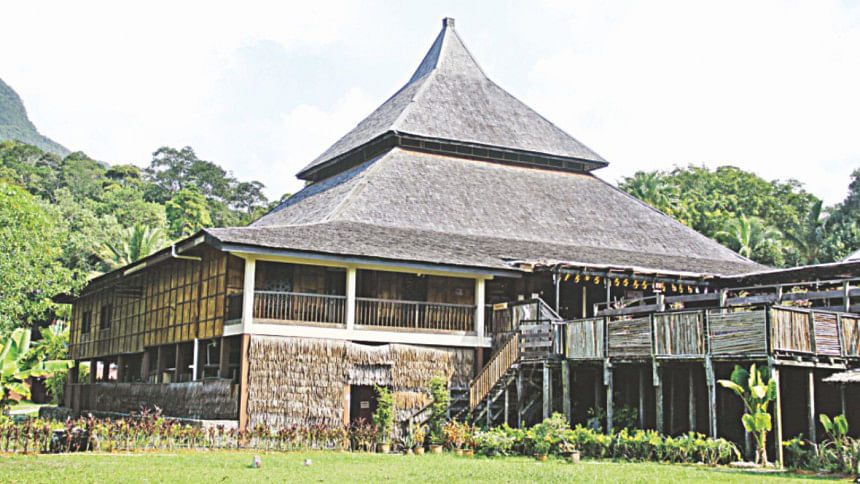Sarawak Cultural Village

Sarawak, situated on the northwest of Borneo Island, is known as the Land of the Hornbills. Forests are its most valuable assets and resources, yielding timber and a large amount of jungle produce. The state's rainforest is a sanctuary to a phenomenal myriad of more than 8000 species of flora and over 20000 fauna, the majority of which are insects. Kuching, the state's capital, is a beautifully landscaped exotic city with the Sarawak River as the center of urban life.
I had a long desire to visit the Malaysian provinces of Sabah and Sarawak. Early in my career I worked at a shipping company and at that time I had many correspondences with two port cities from Borneo.

The island is an exotic location for holidays. It's ideal for those who love nature and are also fond of ethnic crafts and heritage. Although, Borneo is a little far from Kuala Lampur, early planning on such a journey is economical with many budget airlines flying the route. There are also many affordable tropical resorts to enjoy a relaxing stay.
Sabah is located in the northern part of Borneo. It's famed for its 4095m-tall Mt. Kinabalu, the highest peak on the island, crowned with distinctive granite spires. The island is also known for its beaches, rainforest, coral reefs and abundant endemic wildlife, much of which is within parks and reserves.


Offshore, the Sipadan and Mabul islands are noted diving destinations. The capital of Sabah is Kota Kinabalu. Sabah is often referred to as the "Land typhoon below the wind", a phrase used by seafarers in the past to describe lands south of the belt.
Our first destination was Kota Kinabalu, the capital of Sabah. We were in a small group, consisting of four people, so we generally travelled by a rental car within Borneo. Tarik, Tamim, Erom and I became , my companions, were highly delighted to see the various interesting places. Among the places we visited wetr Baku National Park and Mt. Kinabalu.
We travelled through Sabah for three days and had a short flight to reach the beautiful city of Kuching – Sarawak's capital. The city was historically a part of the British Emperor and still retains its colonial flavour. The architecture gives it a grandiose effect. The ethnic heritages of these provinces are very rich. Many ethnic people still remain here with their gorgeous culture.

As an interior designer, I decided to visit Sarawak's cultural village. Since its opening in 1991, the village has become one of Malaysia's best-known and best-loved tourist attractions and an important showcase for Sarawak's cultures and traditions. It has won a host of awards, both as an attraction and as a centre for the performing arts, and over 70000 visitors a year pass through its imposing wooden gates to enjoy the 'Sarawak Experience'.
The Cultural Village is often referred to as a 'living museum,' but this is only half the story. The village is a living, thriving community, a 'village-within-a-village,' where many of the staff and performers live, work, marry and bring up families, devoting their lives to promoting and preserving the culture and traditions of their beloved Sarawak.
The basis of the village is the house – a remarkably accurate recreation of the types of houses inhabited by Sarawak's main ethnic groups. The long houses are inhabited by the Iban, the Bidayuh and the Orang Ulu. More conventional yet equally fascinating homes are dwelt in by the Malays and the Chinese.

The magnificent tall-house is home to the Melanau and the nomadic Penan who do not live in houses at all. Irrespective of their lifestyle, we visited all of these homes and met the people that lived there.
We noticed as we passed through the village that unlike other museums none of the exhibits are labelled. This is not an oversight but a reflection of Sarawak's rich oral heritage. The indigenous people had no need for the written word. Instead, every community had its bards, poets and storytellers who memorised the tribe's history from their elders, and passed it down word-for-word to an enthralled audience during long, dark tropical nights in the longhouse.
The village residents provide information on their various traditional cultures and lifestyles. You can see replicas of buildings that represent every major ethnic group in Sarawak, longhouses of the Iban, the Bidayuh and the Orang Ulu, a Melanau tall-house and a Chinese farm house among others.

Sprawled across 17 acres, there are about 150 people living in the village, demonstrating traditional daily activities from Sarawak's diverse tribes like the processing of sago and the making of handicrafts. They wear traditional costumes and also put on dances for visitors.
Highlight of a visit to the Sarawak Cultural Village is the performance where professional dancers depict numerous traditional dances, each originating from a different tribe. We were pleasantly surprised by this performance. There were quite a few exciting moments during the 45 minute show.
Besides the houses, there is a traditional restaurant, a handicraft, and souvenir shop. You can even get married at the Sarawak Cultural Village, in traditional Iban, Malay, Bidayuh or Orang Ulu style.
Guests are often invited to attend nightly ceremonies and drink a potent rice wine, tuak, which the Iban make. Comfortable guesthouses are also available for visitors. Early morning these guest houses are fantastic for living, with hundreds of birds coming every day.
After the cultural show we were still able to walk in the village area. Nobody else was there at the late hour, hence the walk was quite relaxing. The village is a fun location to visit for every member of the family. There are many educational activities for everyone to enjoy and therefore it's a must visit location for anyone going to Kuching, Sarawak.
Nazneen Haque Mimi
Interior Consultant
JOURNEYMAN
E-mail: [email protected]
Photo credit: Tamim Sujat

 For all latest news, follow The Daily Star's Google News channel.
For all latest news, follow The Daily Star's Google News channel. 



Comments